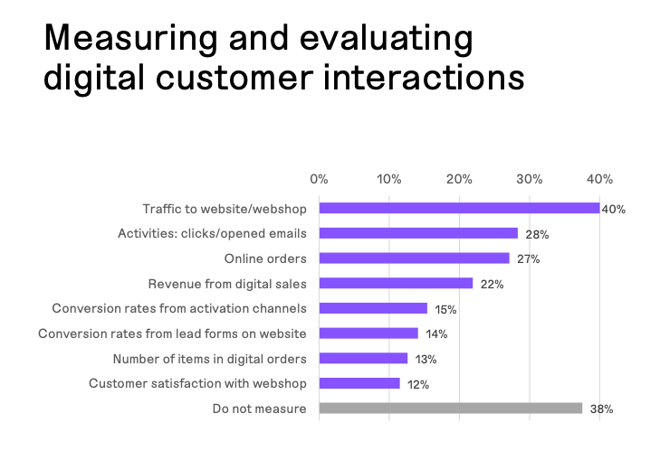Today’s B2B e-commerce has fallen behind in its development compared to e-commerce websites aimed at consumers. Internet giants such as Amazon have made it easy, allowing people to order products to their doorstep with just a few clicks. For B2B companies, the road from purchase to delivery is a bit more complicated, which may have contributed to the late start.
The importance of functionality increases when personal contact disappears
The biggest difference between B2B and B2C in regards to digital purchasing is the order value and the number of products bought in one purchase. Business customers often order a larger amount of products or services which often involves other types of payment and delivery services. Even the process prior to the actual purchase being complete has more complicated steps, compared to B2C. Planning, budgeting and logistics all affect business-to-business e-commerce.
To succeed in B2B e-commerce, it helps to already have an established relationship with one's customers, or a brand they recognise. However, despite having these things in place, companies venturing into the digital arena will need to invest time on in-person or video meetings before their customers place an order online.
When developing your B2B e-commerce, you need to factor in all parts of the online purchasing process. This includes among other things, contracts, custom solutions, and discounts. Very quickly this turns into a complex structure. Things that used to be managed offline are now online, and preferably highly automated.
A safe B2B e-commerce platform puts the customers needs first
An e-commerce platform that is scalable and adapted to the customer needs offers security. Your customers should be able to create their own purchasing-experience. This includes choosing their preferred currency, language, and delivery method. International companies also need to share information on potential taxes and regulations on local markets.
From the suppliers point of view, the platform must be able to easily adapt to new product categories and markets. Headless CMS and integrated PIM help with this and at the same time allows more control over the platform in its entirety.
As a B2B e-retailer, there is great value in adding functions that make it possible for your customers to be more involved in the purchasing process. You can for example have functions that allow your customers to manage and follow up their orders or change delivery dates, all without needing to contact you.
Cloud based and scalable platforms is the way forward
The initial stages of creating a B2B e-commerce website can be expensive and take time as customers are not used to the concept of purchasing your products or services online. Many business customers still like calling or sending an e-mail. This means that you need to have two sales-channels operating simultaneously before going fully online.
However, the upside is huge for companies that stick to the online journey from start to finish. A study analysing B2B commerce shows that annual B2B revenue will increase more than one hundred trillion USD. Online purchasing of B2B products and services are actually estimated to increase more than B2C. In other words, there are major benefits for companies that adapt and position themselves on the market early.
When choosing a B2B e-commerce platform, it is beneficial to choose one that is cloud based and scalable. It is also important that it can support Product Management (PIM) and Content Management (CMS). This allows you to eliminate unnecessary costs, save time in development and speed up the time to market process.
Being fast to market gives you the breathing space you need to find the "magical formula" of higher ROI and decreased churn, whilst increasing your market share. Customers are always looking for more efficient ways of purchasing. With a modern e-commerce platform at your fingertips, you can satisfy your customers needs and further drive development.
Increased sales opportunities with a data driven focus
Today, many B2B companies actively monitor data that comes through their website. The majority of these companies however, only do a basic analysis. In our latest report it shows that 40 percent measure visitors, while 28 percent focus on opened emails and clicked links. Only 12 percent measure the number of satisfied customers and 38 percent do not follow up on data at all.

By gaining a deeper understanding of online customer behaviour, you as a business can offer a more custom digital experience. Learning from existing customers is an important part in understanding how to attract new ones. Thus, actively monitoring and driving traffic is a fundamental factor when building and scaling your B2B e-commerce.
Companies are positive to the development of B2B commerce
Companies venturing into B2B e-commerce are at an advantage, as they can use learnings and insights from B2C e-commerce. Companies such as Amazon, Zalando, Revolution Race and others are beacons when it comes to offering the right product, to the right customer at the right time.
Finally, it is important to remember that the development of B2B commerce is still in an early stage. It can take a while until there is a clear blueprint on how to best build a digital marketplace. It is therefore important to collaborate with an e-commerce platform that can contribute with its expertise.
What we know for certain is that the possibilities for e-commerce in the B2B sector are plentiful. Most companies look at the future with optimism and 74 percent foresee sales to increase in the next three years.
Do you want to know more about Litium and our e-commerce solutions? Contact us today to find out how we can help you succeed in B2B commerce!

